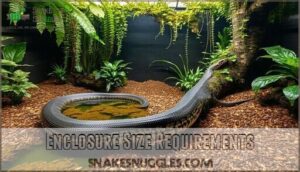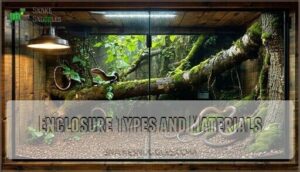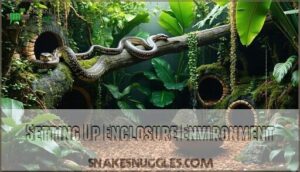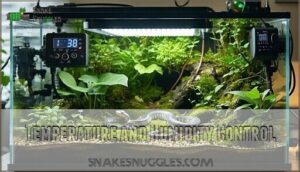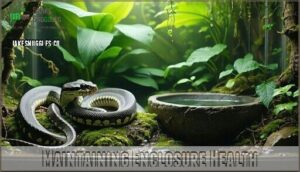This site is supported by our readers. We may earn a commission, at no cost to you, if you purchase through links.
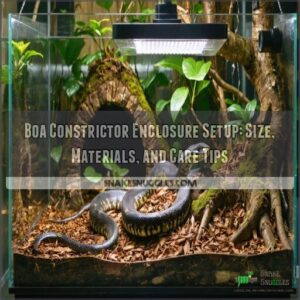
For adults, provide at least a 4’×2’×2′ enclosure with proper ventilation, and maintain a temperature gradient (75-85°F with a 90°F basking spot) and 50-60% humidity.
Include at least two snug hides, climbing branches, a large water bowl, and suitable substrate like cypress mulch or coconut husk.
PVC enclosures often outperform glass tanks for temperature and humidity retention, and regular cleaning prevents bacterial growth, while proper lock mechanisms keep these escape artists contained.
The right setup doesn’t just house your boa—it creates a stress-free environment where natural behaviors flourish.
Table Of Contents
- Key Takeaways
- Enclosure Size Requirements
- Enclosure Types and Materials
- Setting Up Enclosure Environment
- Temperature and Humidity Control
- Maintaining Enclosure Health
- Frequently Asked Questions (FAQs)
- What is the best setup for a boa?
- What do I need for a boa enclosure?
- What do boas like in their cage?
- What size cage does a boa constrictor need?
- Do boa constrictors need an enclosure?
- How do I create a bioactive boa constrictor enclosure?
- How do you create a perfect habitat for a boa constrictor?
- How to care for a boa constrictor?
- What do boa constrictors need in their enclosure?
- How to set up a tank for a boa constrictor?
- Conclusion
Key Takeaways
- You’ll need to scale your enclosure as your boa grows, starting with 2’×1.5’×1′ for babies and eventually providing at least 8’×4’×4′ for large adults, ensuring the sum of length and width equals your snake’s total length.
- Your boa requires a temperature gradient (75-85°F with a 90°F basking spot) and 50-60% humidity, with PVC enclosures typically outperforming glass tanks for heat and humidity retention.
- You should include multiple secure hides on both warm and cool sides, climbing branches for exercise, appropriate substrate like cypress mulch or coconut husk, and a heavy water bowl large enough for soaking.
- You’ll need to maintain enclosure hygiene through daily spot cleaning, monthly deep cleaning with proper disinfectants, and regular substrate replacement to prevent respiratory issues and other health problems.
Enclosure Size Requirements
You’ll need to adapt your boa constrictor’s enclosure size as it grows, starting with a 2’L x 1.5’W x 1’H habitat for babies and eventually providing at least 8’L x 4’W x 4’H for adults.
The minimum space requirement follows a simple formula: the sum of the enclosure’s length and width should equal the snake’s total length, ensuring your boa has adequate room to stretch, explore, and maintain proper muscle tone.
The key to a healthy boa constrictor is providing an enclosure that allows it to stretch and explore, which is crucial for its overall well-being.
Baby Boa Enclosure Sizes
For a baby boa constrictor (under 2 feet in length), you’ll need an enclosure measuring about 2’L x 1.5’W x 1’H.
Give your baby boa room to grow but not so much space that it feels exposed—security matters!
This temporary housing provides enough space for your snake to explore while still feeling secure. Baby boas can become stressed in overly large setups, so proper space utilization is vital.
Monitor your snake closely in this grow-out enclosure to verify it’s thriving before upgrading to juvenile housing. Proper ventilation, such as that described at Proper ventilation, is also extremely important for their health.
Juvenile Boa Enclosure Sizes
For juvenile boas, a 4’L x 2’W x 2’H snake enclosure works well, offering enough space perimeters for growth stages.
Temporary housing, like a 3’x2’x2’ reptile enclosure, can suffice early on.
Consider selecting proper housing for your boa, and include vertical space for climbing and enrichment needs.
Upgrade the boa constrictor enclosure setup as they grow to guarantee proper development and comfort.
Adult Boa Enclosure Sizes
As your boa matures, its enclosure size needs must grow too.
For adult boas (6′ to 8′ in length), you’ll need a minimum enclosure of 6’L x 3’W x 3’H.
When selecting adult boa enclosure sizes, remember:
- The sum of length and width should equal your snake’s total length
- Include adequate vertical space for climbing opportunities
- Consider subspecies differences when planning long-term space needs
Different subspecies require varying space per boa, so measure your snake regularly.
Large Adult Boa Enclosure Sizes
For large adult boas exceeding 8 feet in length, you’ll need an enclosure measuring at least 8’L x 4’W x 4’H.
These impressive snakes require ample space for proper movement and enrichment scaling.
When planning custom builds, consider that the sum of length and width should equal the snake’s length as a minimum requirement.
Space optimization becomes critical for these giants, ensuring their long-term health while managing costs, which is essential for their long-term health.
Minimum Enclosure Size for Boa Constrictors
While providing space for large adults is essential, understanding the minimum enclosure size for all boa constrictors is key.
For proper boa constrictor enclosure setup, follow this simple rule: the sum of length and width should equal your snake’s length.
At minimum, an 8’L x 4’W x 4’H enclosure works for smaller boas, and your snake’s comfort depends on adequate space – they’ll use every inch you provide, which is essential for their well-being.
Enclosure Types and Materials
You’ll need to choose the right enclosure material for your boa constrictor based on factors like heat retention, humidity control, and durability.
PVC and wooden vivariums generally outperform glass terrariums for adult boas because they provide better insulation and maintain consistent environmental conditions, which is crucial for durability.
Glass Enclosures for Boas
Now that you’ve determined the right size for your boa, let’s consider glass enclosures.
They offer excellent visibility benefits for watching your snake, but come with drawbacks.
They’re heavy, expensive, and struggle to maintain proper temperature gradients.
Many owners find they need to research suitable enclosure options for their boas.
While they showcase your boa constrictor beautifully, glass enclosures don’t hold heat or humidity well, often requiring additional equipment for proper reptile tank conditions.
Plastic and PVC Enclosures
While glass enclosures have their place, plastic and PVC options offer superior benefits for your boa.
- PVC enclosures retain heat efficiently, reducing electricity costs
- Lightweight design makes cleaning and relocating much easier
- Custom builds allow for perfect sizing as your snake grows
- Secure latching systems prevent escape attempts
PVC’s durability withstands humidity without warping, making maintenance simple. These enclosures create the stable environment your boa needs while giving you peace of mind about snake enclosure security.
Wood and Melamine Enclosures
Many boa owners choose wood or melamine enclosures for their excellent insulation properties.
Wood materials keep heat in efficiently, making temperature regulation easier.
However, melamine is prone to rot and mold when exposed to high humidity.
If building DIY enclosures, always use waterproof sealants on wood surfaces.
Front-opening designs are best for reducing stress on your snake.
Consider mold-resistant wood options for long-term durability in humid environments.
Recommended Enclosure Manufacturers
While wooden enclosures offer excellent insulation, several manufacturers specialize in ready-made boa habitats.
Based on ReptiFiles recommendations, consider these top options:
- Animal Plastics offers the T60 model (96"×24"×24") with customizable features
- Zen Habitats provides expandable enclosures with free shipping
- Dubia.com sells affordable 4×2×2 options with vented tops
Other quality manufacturers include Kages enclosures, Toad Ranch Luxury Habitats, and Custom Cages, which builds under the Hybrid and Majestic brands, offering a range of ready-made boa habitats.
Setting Up Enclosure Environment
You’ll need to create a habitat that mimics your boa constrictor’s natural environment, including proper hiding spots, climbing structures, substrate, and a water source.
Your enclosure setup directly impacts your snake’s health, stress levels, and overall wellbeing, so attention to these environmental details is essential for proper care.
Providing Hides and Climbing Structures
Your boa’s security is essential for reducing stress.
Provide multiple secure hides on both warm and cool sides of the enclosure.
Add thick climbing branches to utilize vertical space, especially important for juvenile boas who enjoy climbing.
Cork bark works perfectly for ground-level hides, while adding foliage creates visual barriers for privacy.
Many keepers purchase pre-made reptile caves for their ease of use.
Consider installing arboreal hides for enrichment variety, giving your boa options to explore and rest.
Bioactive Substrate Options
Several bioactive substrate options exist for your boa’s enclosure. This self-sustaining ecosystem mimics natural habitats while reducing maintenance needs.
- Coconut fiber base (3-4 inches deep) retains moisture effectively
- Reptile soil mix adds drainage and prevents compaction
- Sphagnum moss increases humidity in specific areas
- Leaf litter provides hiding places for CUC organisms
- Bioactive substrate requires proper moisture levels (55-75%) to function as a self-sustaining ecosystem.
Environmental Enrichment Ideas
Five essential enrichment ideas will transform your boa’s enclosure from basic to engaging.
Add climbing branches at various heights for exercise and exploration. Create a bioactive setup with live plants like Pothos or Snake Plants.
Include multiple hides at both temperature zones. Rearrange decor monthly to stimulate natural curiosity.
Introduce novel objects occasionally to prevent boredom. Strategic environmental enrichment promotes healthy behavior and reduces stress.
Water Bowl Placement and Size
Your boa constrictor needs a heavy water bowl large enough for soaking but won’t tip over.
A sturdy, tip-proof water bowl is essential for soaking and hydration, ensuring your boa stays healthy and stress-free.
Place it on the cool side of the enclosure to prevent humidity spikes near heat sources.
Choose ceramic or plastic bowl materials that are easy to clean, and ensure fresh water availability is essential, so change water daily.
The bowl should be stable enough to withstand your boa’s exploration while contributing to overall humidity impact. Proper ventilation is key, so consider ventilation and humidity to maintain ideal conditions.
Temperature and Humidity Control
You’ll need to maintain proper temperature and humidity levels to guarantee your boa constrictor thrives in captivity.
Creating a temperature gradient from 75-80°F on the cool side to 86-90°F on the warm side, with humidity between 55-75%, mimics their natural habitat and supports essential biological functions.
Creating a Temperature Gradient
To maintain proper thermoregulation, create a temperature gradient in your boa’s enclosure.
Place heat sources like lamps on one side for a basking temperature of 90°F, leaving the opposite side as a cool zone at 75-80°F.
Follow these steps:
- Position a warm hide under heat sources.
- Use a thermostat for precise control.
- Monitor night temperatures (68-75°F).
Ideal Humidity Levels for Boas
Now that you’ve established proper temperature zones, let’s focus on humidity.
Your boa will need average humidity levels between 55-75% for ideal health.
During shedding, increase humidity to 70-80% to prevent stuck shed.
Provide a humid hide with damp sphagnum moss.
Mist the enclosure 1-2 times daily with distilled water.
Consistent humidity monitoring helps prevent respiratory health issues while ensuring proper hydration levels.
Heating and Lighting Equipment Options
When selecting heating and lighting equipment for your boa constrictor, prioritize safety and effectiveness. The right setup creates proper temperature gradients while preventing burns.
Choose from these essential options:
- Ceramic heat emitters for consistent 24-hour heat without light
- Radiant heat panels for energy-efficient surface heating
- UVB lamps paired with basking lights for both heat and beneficial lighting
Always connect heat sources to a reliable thermostat for proper temperature control, ensuring a reliable setup.
Humidity Monitoring and Control Methods
To properly maintain your boa constrictor’s health, monitor humidity levels with a digital hygrometer placed at mid-level in the enclosure.
Keep humidity between 55-75% through daily misting, typically once in the morning and again at night if needed. Substrate choice impacts moisture retention—coconut fiber holds humidity well.
A humid hide filled with damp sphagnum moss helps during shedding periods. Live plants naturally boost humidity control while adding environmental enrichment.
Proper airflow, achieved through strategic vent placement, also aids in maintaining consistent humidity, which is crucial for the overall health of your boa constrictor, and supports its natural behavior in a well-maintained enclosure.
Maintaining Enclosure Health
You’ll need to maintain proper enclosure hygiene through regular cleaning and substrate management to prevent health issues in your boa constrictor.
Consistent monitoring of the environment guarantees the best conditions for your snake’s respiratory health and overall wellbeing.
Cleaning and Disinfecting Enclosures
Regular cleaning is essential for your boa’s health.
Spot clean waste daily and perform deep cleaning monthly. Use a bleach solution (1:10 ratio) or veterinary-grade disinfectants like F10SC for thorough sanitization.
Always remove your snake before cleaning. Wipe down surfaces, rinse thoroughly, and make certain complete drying to prevent mold growth.
Clean water bowls every 2-3 days to prevent bacterial buildup and maintain proper hygiene.
Substrate Maintenance and Replacement
Now that your enclosure is clean, let’s talk about keeping your boa’s substrate in top condition.
You’ll need to spot clean daily, removing waste and soiled substrate immediately. For deeper cleaning, replace 25-30% of naturalistic substrate monthly.
In bioactive enclosures, monitor your cleanup crew’s effectiveness. Complete substrate replacement should happen every 3-6 months, depending on enclosure size and your boa’s habits.
Watch for mold growth—it’s a sign your substrate needs attention, and perform spot clean daily, and consider complete replacement every few months.
Preventing Respiratory Issues
While maintaining clean substrate forms the foundation of a healthy enclosure, your boa’s lung health depends on proper environmental conditions.
Maintain humidity levels between 40-60% daily, increasing to 70% during shedding.
Good ventilation prevents mold growth and respiratory infections, and it is crucial to never use pine or cedar substrates as they contain harmful oils.
For ideal airflow, consider strategic screen placement within the enclosure to ensure good ventilation and install a hygrometer to monitor humidity.
Guarantee heating equipment maintains temperatures between 80-94°F consistently to protect your boa’s respiratory system.
Monitoring Boa Health and Behavior
Your boa’s behavior speaks volumes about its health.
Watch for normal feeding habits, consistent defecation schedule, and complete shedding without problems.
Healthy boas show regular activity levels, clear eyes, and smooth scale condition.
If you notice wheezing, bubbles around nostrils, or unusual postures, these could indicate respiratory signs or stress.
Daily observation helps catch potential issues before they become serious health concerns for your snake.
Frequently Asked Questions (FAQs)
What is the best setup for a boa?
Home sweet home for your boa needs an 8’L x 4’W x 4’H enclosure.
With this enclosure, it is essential to have a temperature gradient (75-90°F), 55-75% humidity, multiple hides, climbing branches, and a large water bowl for soaking.
What do I need for a boa enclosure?
You’ll need an appropriately sized enclosure (based on your boa’s length).
Proper substrate, multiple hides, climbing branches, a secure lid, water bowl.
Heating elements, thermometer/hygrometer, and UVB lighting for a complete setup.
What do boas like in their cage?
Like a hermit craving solitude, your boa needs multiple secure hides, climbing branches, a large water bowl for soaking, proper substrate, and naturalistic decorations.
That create a maze-like environment mimicking their wild habitat, is essential for their well-being, and it is crucial to provide a naturalistic setting.
What size cage does a boa constrictor need?
The size of your boa’s enclosure should grow with them.
You’ll need minimum dimensions: baby (2’×5’×1′), juvenile (4’×2’×2′), and adult (6’×3’×3′).
Larger adults over 8′ require 8’×4’×4′ spaces.
Do boa constrictors need an enclosure?
Boa constrictors thrive in enclosures that mimic their natural habitat.
A secure, well-ventilated terrarium with proper heating, humidity, and space for climbing and hiding guarantees their health, safety, and overall well-being.
How do I create a bioactive boa constrictor enclosure?
Your reptilian oasis requires a PVC enclosure with drainage layer, bioactive substrate mix, springtails, isopods, humidity-tolerant plants like pothos, and proper temperature gradient.
You’ll create a mini-ecosystem that maintains itself while your boa thrives, ensuring a healthy environment for your pet.
How do you create a perfect habitat for a boa constrictor?
Provide a spacious PVC enclosure with proper temperature gradient (75-90°F), 55-75% humidity, multiple hides, climbing branches, secure water bowl, and appropriate substrate.
You’ll need UVB lighting and enrichment items for stimulation to ensure the well-being of the animal, with enrichment being a crucial aspect of its care.
How to care for a boa constrictor?
You’ll need to maintain proper temperature gradients (75-90°F), humidity (55-75%).
Feed appropriately sized prey monthly, provide fresh water daily.
Handle your boa gently for 10-15 minutes a few times weekly.
What do boa constrictors need in their enclosure?
Spacious homes protect, small cages endanger.
Your boa needs a properly sized enclosure with temperature gradient (75-90°F), adequate humidity (55-75%), multiple hides, climbing branches, secure lid, water bowl, and appropriate substrate.
The enclosure should have a secure lid to prevent escape and ensure the boa’s safety.
How to set up a tank for a boa constrictor?
Your boa’s tank needs size-appropriate dimensions.
Proper heat gradient (85-90°F warm side, 75-80°F cool side), 55-75% humidity, and a secure lid are essential.
Multiple hides, climbing branches, and a heavy water dish for soaking are also necessary.
Conclusion
Like a snake shedding its old skin, your approach to boa constrictor enclosure setup will evolve over time.
You’ll find that investing in proper space, temperature control, and enrichment pays off with a thriving, active pet.
Remember, your boa’s home isn’t just a glass box—it’s their entire world.
With consistent maintenance and attention to their specific needs, you’ll create an environment where your magnificent constrictor can live its best life for decades to come, and this will be a result of your dedication to providing the right conditions for your pet to thrive in its entire world.
- https://www.zenhabitats.com/collections/zen-habitats-reptile-enclosures?aff=5
- https://reptilekages.com/collections/premium-reptile-enclosures?ref=9
- https://www.facebook.com/groups/building.reptile.cages/
- https://www.inaturalist.org/observations?taxon_id=32092
- https://flickr.com/search/?text=boa%20constrictor%20wild

